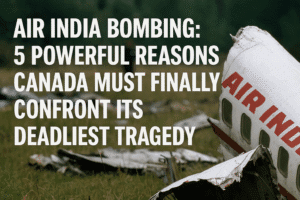Air India Bombing: 5 Powerful Reasons Canada Must Finally Confront Its Deadliest Tragedy
Canada still fails to fully recognize the 1985 Air India bombing as its own national tragedy, despite 280 Canadian citizens perishing in the attack. Ambassador Bob Rae emphasizes that initial responses wrongly framed it as an “Indian community” event, overlooking the devastating reality: the bombs were built and the plot executed on Canadian soil by Canadian extremists. While Rae’s 2005 inquiry led to memorials and a National Day of Remembrance for Victims of Terrorism, the profound narrative remains unembedded in Canada’s historical consciousness. The attack, proportionally akin to 9/11 for Canada, exposes enduring failures to confront homegrown extremism and honor victims as fellow citizens.
Yet, a powerful counter-narrative endures in Ahakista, Ireland, where grieving families and the local community forged deep bonds through decades of remembrance and scholarships. True healing requires Canada to finally claim this history – teaching its lessons, acknowledging its failures, and honoring the 329 lives lost as an indelible part of the national story. The quiet Irish memorial stands as a testament to the solace found through acknowledgment, a solace still needed at home.

Air India Bombing: 5 Powerful Reasons Canada Must Finally Confront Its Deadliest Tragedy
The serene memorial at Ahakista, Ireland, overlooking the Atlantic where Air India Flight 182 fell 40 years ago, stands in stark contrast to the unresolved anguish carried by Canadian families across the ocean. Ambassador Bob Rae’s recent pilgrimage there underscores a painful truth: Canada’s deadliest terrorist attack remains, for many, a forgotten chapter, obscured by historical neglect and misplaced perception.
Rae, whose 2005 report forced a reckoning with the bombing’s aftermath, voiced a sentiment long held by victims’ families: “It really was seen as sort of an event affecting the Indian community, ignoring the fact that the vast majority of the people on the flight were Canadians.” This initial framing wasn’t just insensitive; it was a fundamental failure to recognize the attack as a Canadian tragedy born of Canadian extremism.
The Core of the Tragedy, Rooted in Canada:
- Canadian Victims: Of the 329 lives extinguished, 280 were Canadian citizens. They were families, students, professionals – a cross-section of Canada itself.
- Canadian Perpetrators: The bomb was built in British Columbia by Canadian citizens. The plot was conceived and executed on Canadian soil.
- Canadian Denial: As Rae noted, there was “a huge degree of denial in the community” about the origins of the attack, allowing harmful conspiracy theories to fester instead of confronting uncomfortable truths about homegrown extremism.
Progress Made, Memory Fragile:
Rae’s work undeniably spurred change:
- Public Memorials: Physical spaces for remembrance now exist across Canada.
- National Day: June 23rd is officially the “National Day of Remembrance for Victims of Terrorism.”
- The Inquiry: The subsequent Major Commission exposed critical intelligence and investigative failures.
Yet, Rae poignantly observes, “the narrative of what took place is still not embedded in the country.” Memorials and designated days are crucial, but they are not enough if the story itself isn’t taught, understood, and internalized as a defining moment in Canadian history. Proportionally, its devastation rivaled 9/11 for Canada, yet its place in the national consciousness pales in comparison.
The Enduring Human Bonds:
Ahakista reveals a profound counter-narrative to the neglect: the deep, enduring connection forged between grieving Canadian families and the Irish community. For decades, families like Babu and Padmini Turlapati (who lost their two young sons) have returned to this remote coastline. Their establishment of scholarships for local Bantry students isn’t just charity; it’s a testament to the solace found in shared humanity and the unwavering respect shown by the Irish people who recovered the victims and continue to honour them. This bond, nurtured over 40 years, stands as a powerful rebuke to the initial indifference encountered back home.
Why This Matters for Canada Today:
- Owning Our History: Recognizing the Air India bombing as a Canadian tragedy is essential for historical integrity. It forces confrontation with the reality that terrorism and violent extremism can originate within our borders and target our citizens.
- Honouring the Victims Fully: The victims deserve remembrance not as distant statistics or members of a specific diaspora, but as fellow Canadians whose lives were brutally taken in an attack against their country.
- Learning from Failure: The intelligence lapses, inter-agency conflicts, and investigative missteps exposed by the inquiry offer vital, ongoing lessons for national security.
- Combating Extremism: Understanding the roots of the Sikh extremism that fueled this attack, and the community denial that followed, remains crucial in addressing all forms of violent radicalization today.
- The Power of Acknowledgment: The solace families found in Ireland highlights the profound healing power of genuine acknowledgment and community support – something initially lacking in Canada.
The Path Forward:
Bob Rae is right. Embedding this narrative requires more than stone monuments and annual statements. It demands:
- Education: Integrating the Air India bombing, its causes, failures, and legacy, into school curricula across Canada.
- Public Discourse: Consistently including it in discussions of Canadian history, terrorism, multiculturalism, and national security.
- Leadership: Continued, visible acknowledgment by political leaders at all levels, reflecting its significance.
- Amplifying Family Voices: Ensuring the experiences and perspectives of the victims’ families remain central to the narrative.
The quiet memorial in Ahakista, embraced by the Irish sea and community, holds a mirror to Canada. It reflects both the profound loss and the enduring love of the families, but also the shadow of a nation still grappling to fully claim a pivotal, painful part of its own story. Until the Air India bombing is unequivocally etched into Canada’s historical memory as Canada’s tragedy, the journey towards true recognition and healing remains incomplete. The 329 Canadians lost, and the families who carry their memory, deserve nothing less.
You must be logged in to post a comment.